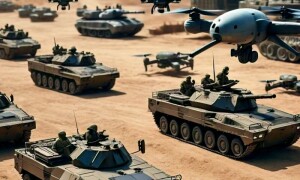BY any measure it is a stunning reversal. Three years ago Somalia’s central ‘government’ controlled little more than a square mile of the capital, Mogadishu, while Islamist militants began to impose strict Sharia law on most of the country.
Today it is Al Shabaab that has not only been driven out of the capital but looks set to relinquish its last major urban stronghold, the port city of Kismayo.
The turnaround has been achieved by a display of purpose from the African Union. Its 17,000-strong peacekeeping force, Amisom, led by troops from Uganda, Kenya and Burundi, has turned the tide against the extremists.
Behind the scenes is another satisfied party: the US. Al Shabaab is an affiliate of Al Qaeda and seen as fair game in the so-called war on terror. The US has carried out air strikes against suspected members and provided training and equipment to Amisom.
The loss of Kismayo could be a terminal blow to Al Shabaab, depriving it of revenue. In the meantime, Somalia has gained a new president and government, thousands of expatriates are heading home and the country has its best chance of peace for 20 years.
However, cries of mission accomplished would be premature. Al Shabaab has reportedly been distributing weapons and may count on local sympathy if it clings on, seeking to test Kenyan soldiers’ stomach for prolonged warfare.
In July 2010, Al Shabaab carried out suicide bombings in Kampala as revenge for Ugandan involvement in Amisom. And with Kenyan troops fighting on the beaches of Kismayo, the next target could be Nairobi.
Perhaps the biggest threat is the vacuum Al Shabaab will leave behind. While Somalia’s president, Hassan Sheikh Mohamud, has more legitimacy than his predecessors, clan factionalism has not gone away.
The Kenyan army has been supported by Ras Kamboni, a local militia likely to expect a slice of Kismayo’s lucrative cake.
Ethiopia and Kenya may also agitate through proxy militias.
“The big danger is Ogaden retaliation against Marehan people,” says one regional analyst, who does not wish to be named.
“Both are Darod sub-clans but the Marehan [in effect] sided with Al Shabaab’s leadership to help oust the warlord Sheikh Ahmed Madobe, leader of Ras Kamboni, from Kismayo. His support is among Ogaden who might want revenge.” — The Guardian, London










































Dear visitor, the comments section is undergoing an overhaul and will return soon.